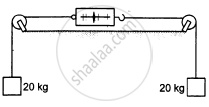Advertisements
Advertisements
Question
State Newton’s first law of motion. Give two examples to illustrate Newton’s first law of motion.
Solution
According to Newton’s first law of motion:
A body at rest will remain at rest and a body in motion will continue in motion in a straight line with a constant velocity, unless it is compelled by an external force to change its state of rest or of uniform motion.
Examples:
(a) A book lying on a table cannot change its state of rest unless an external force is applied on the book.
(b) A car set free on a sloppy road will continue to be in motion unless an external force applied by hands or brakes to bring the car to rest.
APPEARS IN
RELATED QUESTIONS
When a carpet is beaten with a stick, dust comes out of it. Explain.
What is the other name of Newton’s first law of motion ?
A moving bicycle comes to rest after sometime if we stop pedalling it. But Newton’s first law of motion says that a moving body should continue to move for ever, unless some external force acts on it. How do you explain the bicycle case ?
Find the acceleration produced by a force of 5 N acting on a mass of 10 kg.
The figure shows a light spring balance connected to two blocks of mass 20 kg each. The graduations in the balance measure the tension in the spring. (a) What is the reading of the balance? (b) Will the reading change if the balance is heavy, say 2.0 kg? (c) What will happen if the spring is light but the blocks have unequal masses?

A block of 2 kg is suspended from a ceiling by a massless spring of spring constant k = 100 N/m. What is the elongation of the spring? If another 1 kg is added to the block, what would be the further elongation?
Explain the following :
After alighting from a moving bus , one has to run for some distance in the direction of bus in order to avoid falling .
What do you mean by inertia of rest?
Differentiate between gravitational mass and inertial mass.
If a 5 N and a 15 N forces are acting opposite to one another. Find the resultant force and the direction of action of the resultant force.
